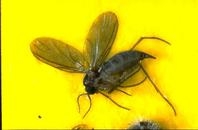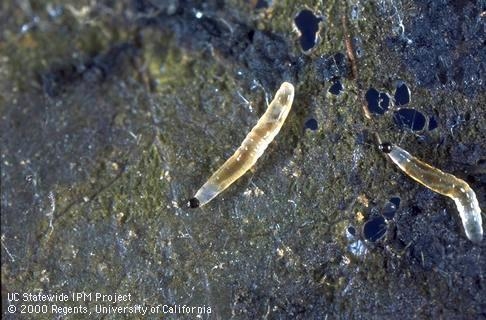Fungus gnat on a sticky trap. Photo by Jack Kelly Clark.
Fungus gnat larvae. Photo by Jack Kelly Clark.
If you suspect you have fungus gnats, yellow sticky traps placed on the surface of the plant soil will trap the adults. Larvae can be monitored by placing chunks of raw potato in your plants, with the cut side down on the soil. The larvae will enter the potato, at which point you can throw it away and replace it with fresh chunks.
If you determine that you have a fungus gnat problem, there are a couple of biological control agents that will control them in pots and container soil mixes. These include Steinernema nematodes, Hypoaspis predatory mites, and the biological insecticide Bacillus thuringiensis subspecies israelensis (Bti). Bti is readily available in retail nurseries so it may be the easiest agent to acquire. Bti doesn't persist or reproduce indoors, so you may have to do repeated applications at about 5 day intervals to provide control. Nematodes and mites can be mail-ordered but are live and perishable, so must be applied immediately upon receipt. Nematodes can reproduce and provide longer term control of fungus gnats. If your fungus gnats are an outdoor problem, several natural predators will help manage the population, including predatory hunter flies. Avoid broad spectrum insecticides to conserve these and other natural enemies.
For more information, take a look at the UCANR literature on fungus gnats here and here. Don't forget to subscribe to our blog so that you receive an email notification when a new post goes up. If you have questions, contact us online, by phone or in person to get answers to your gardening quandaries!

